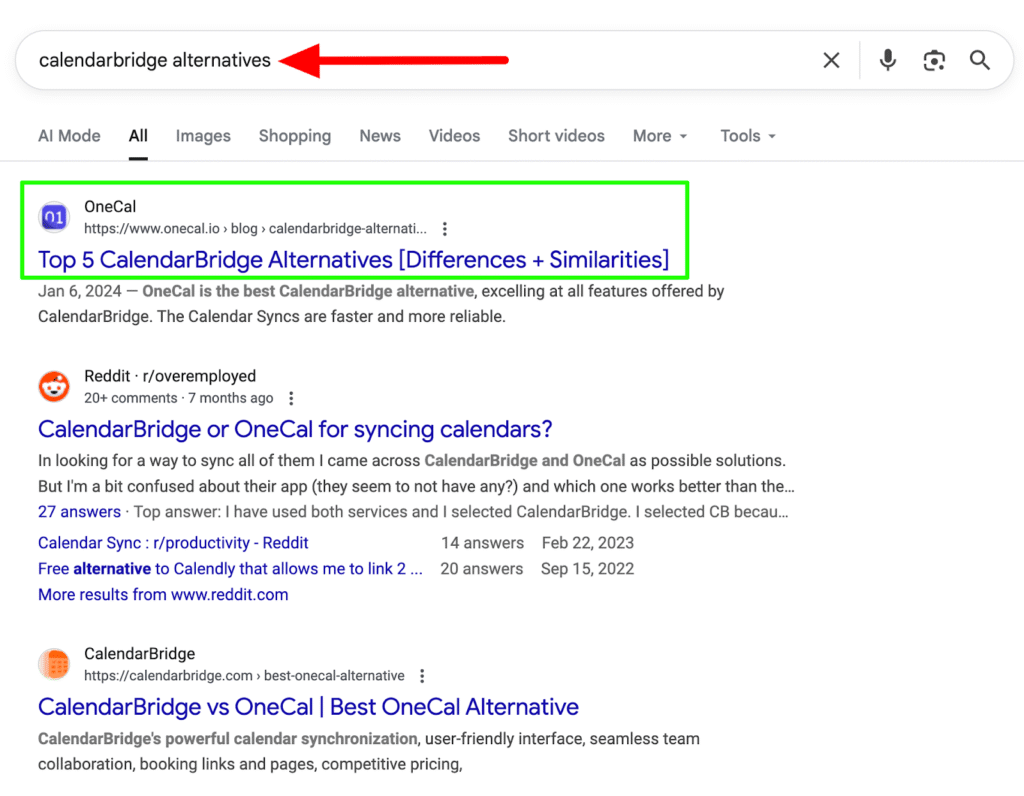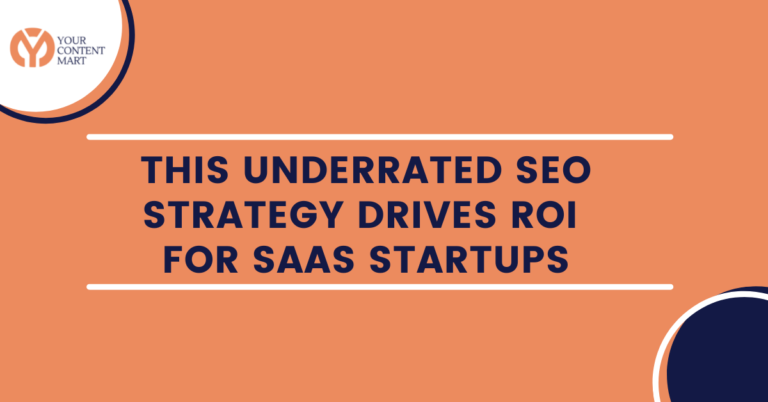It started with a free SEO audit on LinkedIn.
OneCal’s co-founder, Eraldo submitted their calendar sync tool, and I delivered a straightforward assessment: they had solid positioning and a clear homepage, but were missing strategic opportunities to compete in organic search.
A few months later, I got this LinkedIn message:
“We’d love to have a call and discuss a possible collaboration…”

As you can see, they have implemented my suggestions and seen results.
They had ideas for further improvement, but needed strategic expertise to connect SEO efforts to actual revenue growth.
But here’s what we were really up against…
TABLE OF CONTENTS
The Problem: Invisible While Competitors Dominated
When OneCal came to us in July 2023, they were competing against well-funded players in the calendar sync space. Reclaim.ai had raised $6.3M and was soon to be acquired by Dropbox at a $25M valuation.
Calendar Bridge and Motion were both VC-backed with resources to invest heavily in content and SEO.
OneCal was bootstrapped. They were getting around 8,000 monthly clicks from organic search and ranking at position #9 for “calendar sync software”, their core keyword. Not terrible, but not good enough, as most searchers never scroll past the top 3-5 results.
The founders believed their product was better than the competition. However, they couldn’t outspend these companies on content teams or link building campaigns. While competitors had dedicated SEO agencies and could publish content at scale, OneCal had to be more strategic with every dollar and every piece of content.
The real challenge was straightforward: their competitors had higher domain authority. That meant even with decent content, OneCal struggled to rank above them for the same keywords. Going head-to-head on the obvious terms wasn’t going to work.
OneCal needed a different approach.
Competing against better-funded players in your niche? Let’s identify the gaps they’re missing.
The Solution: Building Authority Where Competitors Had Gaps
Instead of trying to outrank competitors on the same keywords where their domain authority gave them an advantage, we took a different approach: build comprehensive topical authority in areas they’d overlooked.
Here’s how we did it:
1. Update Existing Content First (Quick Wins)
OneCal already had pages targeting important keywords, such as “Google Calendar sync software” and “Outlook calendar sync.” But many were thin, some as short as 268 words, and were missing key elements that would help them rank.
We didn’t start by creating new content. We recommended improving what they already had. We expanded thin pages, added missing sections, optimized title tags and headings, and made the content more comprehensive.
This gave us early momentum. Pages that were stuck on page 1 began to move up. More importantly, it showed the strategy was working.
2. Build Topical Authority Through JTBD Content
This became our foundation. Instead of targeting high-volume keywords that competitors already dominated, we focused on what people were actually trying to accomplish with calendar sync tools.
We created content around jobs to be done:
- “How to sync Outlook and Google Calendar”
- “How to sync Outlook calendar with Apple Calendar”
- “How to block time on Google Calendar”
These weren’t the obvious, high-competition keywords. But they were what people searched for when they had a real problem to solve. And OneCal’s product directly solved these problems.
This approach did two things: it brought in traffic from people actively looking for solutions, and it established OneCal as the authority on calendar syncing, not through a single hero page, but through comprehensive coverage.
3. Fill the Alternatives Content Gap

OneCal had comparison pages for their competitors (like “OneCal vs Calendar Bridge”). But we noticed something: they didn’t have proper alternative pages.
This was a gap their well-funded competitors had also missed.
We created alternative content like: “Calendar Bridge alternatives,” “Calendly alternatives,” and similar pages, positioning them as listicles that featured OneCal alongside other options.
Today, when you search “Calendar Bridge alternatives,” OneCal ranks #1 on Google (right above Reddit and Calendar Bridge’s own site).
Want to see if your SaaS could achieve a similar positioning in search results? Book a free competitive analysis.
The Results: From 8,000 to 31,300 Monthly Clicks From Google in 5 Months
Five months of focused execution delivered results across traffic, rankings, and competitive positioning.
More importantly, it laid a foundation that continued to work long after our engagement ended.
Here’s what changed:
Building a Sustainable Organic Traffic Engine
In roughly 5 months (July 2023 to January 2024), organic clicks grew from 8,000 to 31,300 per month, a 291% increase. Impressions jumped from around 1 million to over 4 million monthly.
This mattered because organic search was essentially OneCal’s entire customer acquisition strategy. They weren’t running major paid ad campaigns. Every click represented someone discovering their product who wouldn’t have found them otherwise.
The JTBD content became consistent performers. “How to sync Outlook and Google Calendar” ranked in featured snippets. “How to block time on Google Calendar” appeared in People Also Ask boxes. Multiple how-to articles landed on page 1.
These brought in people actively trying to solve problems, exactly the audience OneCal needed.
The foundation we built kept working after we stopped.
By September 2024, seven months after our engagement ended, OneCal had reached 40,000 monthly clicks. The content continued attracting traffic without ongoing investment.

Strategic Wins Over Competitors
The alternatives content filled the gaps competitors had missed. “Calendar Bridge alternatives” now ranks #1 on Google, right above Reddit and Calendar Bridge’s own site. We created similar alternatives pages for other competitors, positioning OneCal in front of people actively evaluating options.
OneCal moved up from position #9 for “calendar sync software.” They went from barely visible to competing directly with VC-backed companies on the first page. The combination of updated existing content and comprehensive JTBD coverage made it possible to rank alongside companies with much higher domain authority.
They weren’t outspending competitors. However, they were appearing in the right searches, the ones where someone was actually making a decision.
The AI Overview Result
Here’s something we didn’t expect: when you search for calendar sync software on Google today, the AI Overview leads with OneCal. Not Calendly. Not Reclaim.ai. OneCal.

Google’s AI mentions OneCal first, before Calendar Bridge, Motion, and Reclaim.ai. AI Overviews pull from content Google considers most helpful and comprehensive for the query. OneCal earned this spot through the JTBD content we created.
A bootstrapped startup with a small team became the first recommendation over competitors with millions in funding. That’s what happens when you build genuine authority instead of trying to outspend everyone.
Want to explore how strategic SEO could work for your SaaS? Book a strategy session.
Key Takeaways
If you’re a bootstrapped startup struggling to drive signups and paying customers from organic search, here are some things you can learn from OneCal.
Bootstrapped doesn’t mean disadvantaged; it means you have to be smarter
OneCal couldn’t hire multiple agencies or publish content at the scale their competitors did. So they didn’t try to. They found gaps: JTBD content competitors weren’t creating, alternative pages nobody had built, and thin existing pages that needed expansion. You don’t beat well-funded competitors by matching their tactics. You beat them by being more strategic.
Target what people are trying to accomplish, not only what they’re searching for
“How to sync Outlook and Google Calendar” had people with actual problems that OneCal could solve. JTBD content brought in fewer total visitors but more qualified ones. And it built the kind of comprehensive authority that earns Google AI Overview positioning.
Quick wins first, big bets second
OneCal didn’t start by creating 50 new articles. They updated existing pages, expanded thin content, fixed technical issues, and improved what was already ranking. This delivered early momentum and proved the approach worked before committing to larger content initiatives. Start with what you have, then build from there.
Good SEO compounds long after you stop
Seven months after we stopped working together, OneCal’s traffic had grown from 31,300 to 40,000 monthly clicks. When you build genuine authority instead of chasing rankings, the foundation continues to work. That’s the difference between sustainable growth and temporary wins.
Struggling to Compete Against Better-Funded Players on Google? Let’s Talk.
OneCal’s situation isn’t unique. Most bootstrapped SaaS companies face competitors with bigger budgets, more resources, and years of accumulated domain authority.
But budget advantages don’t guarantee search visibility. Strategic SEO does.
If you’re a bootstrapped founder tired of watching well-funded competitors dominate search results while you struggle for visibility, let’s talk. We’ll analyze your competitive landscape, identify gaps they’ve missed, and build an SEO strategy that doesn’t require matching their budgets.



